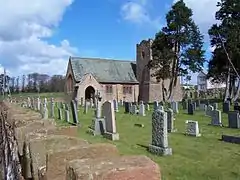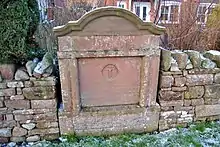Plumpton, Cumbria
Plumpton or Plumpton Wall is a small village about 4 miles (6 km) north of Penrith, Cumbria, England.
| Plumpton | |
|---|---|
 St. John the Evangelist parish church, Plumpton | |
| OS grid reference | NY496372 |
| Civil parish | |
| District | |
| Shire county | |
| Region | |
| Country | England |
| Sovereign state | United Kingdom |
| Post town | PENRITH |
| Postcode district | CA11 |
| Dialling code | 01768 |
| Police | Cumbria |
| Fire | Cumbria |
| Ambulance | North West |
| UK Parliament | |
The village
The village is made up of the former separate hamlets of Salkeld Gate and Brockleymoor and consists mainly of houses along a minor road connecting the A6 to the B5305 near Skelton and also a few houses and farms along the A6 itself.
Close by are the settlements of Plumpton Head, Plumpton Foot and Plumpton Street.
The earthwork remains of a substantial Roman fort can be seen at Castlesteads Farm, alongside the A6 road just north of the village. The fort was known in antiquity as Voreda. The A6 follows the course of the Roman road from Carlisle to Brougham.
The village has an Anglican church, (St John the Evangelist by Robert Lorimer[1]), a primary school, café and garden centre (the Pot Place), however the Post Office closed in 2016. During the daytimes on Mondays to Saturdays there is a half-hourly bus service to Penrith and Carlisle which has a reduced service in the evenings and on Sundays.
Plumpton (Cumbria) railway station was opened by the Lancaster and Carlisle Railway on 17 December 1846. It lay on the West Coast Main Line but after ownership by the London and North Western Railway and the London Midland and Scottish Railway it was closed by British Railways on 31 May 1948 soon after nationalisation.
Plumpton is within the civil parish of Hesket but was from 1866 to 1934 a separate parish under the name of Plumpton Wall. Before that it was a chapelry or township of Lazonby parish.
The nearby areas of Plumpton Head, Plumpton Street and Plumpton Foot were not part of Plumpton parish but in Penrith or Hesket-in-the-Forest parishes.
Murder

Murder of PC Joseph Byrnes by the "Netherby" burglars. On October 29, 1885 PC Byrnes was shot in the head by a notorious gang, named the Netherby burglars by the memorial stone. The stone reads "Here constable Joseph Byrnes fell on the night of October 29, 1885, shot by the three Netherby burglars, whom he single handed endeavoured to arrest". The British Transport Police have a historic report on the events.
Presbyterian chapel

The Presbyterian chapel was built around 1850 era, though the exact date is unknown. The chancel on the back was thought to have been built later, however the internal construction suggests it is of the same era. It was acquired by the Wesleyans in 1887 and opened on 17 Aug 1888. It closed its doors as a chapel in 1952.[2] In 1966 it was purchased and converted into a private residence.
St. John the Evangelist parish church
The church is unusually modern for an older village, the sandstone date block reads 1907. It comes under the Christ Church parish in Penrith.[3] The church is set in a square wall with surrounding graveyard. Its stained glass windows were designed by William Morris.[4]
See also
References
- Dictionary of Scottish Architects: Robert Lorimer
- "Plumpton, village WM Chapel, Cumbria". My Wesleyan Methodists. Retrieved 2 January 2021.
- "Penrith Team Ministry - Christ Church Penrith". www.christchurchpenrith.org.uk. Retrieved 2 January 2021.
- "William Morris in Cumbria". Visit Cumbria. Retrieved 2 January 2021.
External links
![]() Media related to Plumpton, Cumbria at Wikimedia Commons
Media related to Plumpton, Cumbria at Wikimedia Commons







